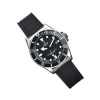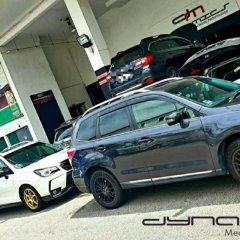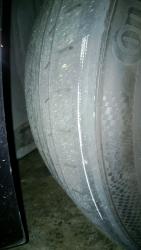Search the Community
Showing results for tags 'TYRES'.
-
http://tinyurl.com/ko5ege5 http://tinyurl.com/bvosxm2 came across the articles above about new tire designs that will not run flat. will you give it a try? the design leaves much to be desired IMHO, but it is the features that is enticing. I wonder how much they will cost if it is brought in locally.
-
Found this video on the internet... amazing feat indeed.. http://www.youtube.com/watch?feature=player_embedded&v=MQm5BnhTBEQ
- 24 replies
-
- 1
-

-
- fun
- entertainment
- (and 4 more)
-
Whenever I washed my car every few weeks, I observed that the 2 front wheel rims always have oil stains whereas the 2 back rims only have normal dirt. Is it normal or something is leaking somewhere?
-
Recently heard of this from someone who parallel imported tyres, is there such thing as Left Hand Drive and Right Hand Drive tyres? I can't make logical sense of what's the difference between tyres for LHD and RHD. Google search don't give anything conclusive. Any expert can enlighten? Thanks.
-
Thinking of buying new tyres? I list out some of the popular tyres that i personally have tried or tried (from my fren's cars). Tyres are major investment, buying a tyres that doesn't suit your car and your driving style will be like have a beautiful girlfriend that always wear oversize t-shirt and jeans. You need to wait for it to wear off or a sudden tyre puncture before getting a new set. It may be a drag till then. And let be honest. tyres shop owner are like used car dealer. They will always push you with the best profit margin ones or the ones that gonna reach the 1 year mark from manufacturing. And buying tyres now have so many variety and some are even from parallel importers. So how do we know what we are paying for? And what are the popular tyres among the roads? The simplest solution is to buy the same tyres your car came with, and that's a good option - after all, the engineers designed the suspension to match the OEM rubber. So you can't get wrong with it. But if you like something more grip, can withstand tyre puncture or much silent tyres, i will start with my recommendation. Bros here are welcome to add in!!! UHP tyres Dunlop Direzza Sports Z1 Good thing don't come cheap, cheap thing don't come good but this tyres really mix this equation by abit. At a affordable range, this rubber grip well during the dry weather and the handling is superb. Highly responsive in when turning to make the car smooth in transmission. Highly Recommended! Run Flat Tyres Pirelli Cinturato P7 Run Flat Only for those who boot that have not enough space, wanna save weight for fuel saving, or have no expertise on changing tyres and wanna play save. This is the tyres you should take note. The engineers in Pirelli have a very vast knowledge in motorsport racing even thou last F1 there is tyre explosion during the race. But they have understudy the racing characteristic and created this green yet performance level tyres. It have fuel saving technology, eco compatible material to make it "green" and longer lasting thread life (which i don't think so.) But never the least, Handling during the dry and even the wet is impressive. This can be a track tyres in my humble opinion. The only downside might be the noise. But when u are driving at 140km/h, i am sure you will focus in your steering more than the noise it produces... Super Quiet Tyres Goodyear Eagle F1 Asymmetric 2 With its latest ActiveBraking Technology, this isn't a gimmick that goodyear come out with. Great response and oother than that. This tyres give you a quite ride. That's all i am gonna say. Come share your tyres review and best is you got lobang to share lah. Currently still at 16" (:
-
Hi guys! Anyone knows of any tyre workshops that buy used tyres? Can list or PM me the workshop if know any? Have a set of 16' excellent condition Yoko A13 tyres to sell, not sure if workshop buy them. Thanks in advance!
-
Hi, For some reason I am not given the option to post replies to any thread in the Tyres and Rims forum. All other forums are fine. Can anyone help? Thanks.
-
hey forum mates! My current tyres are eagle F1 Thai GSD3. mileage aready 65000km. Am driving a picnic with 15inch rims. any advise if i should change to GR80 or back to F1? i want comfort, good wet, QUIET, durable, Fuel economical etc oops i know i'm askin f0r alot
-
For heaven sake, the sake of your family and friends riding with you and your fellow drivers around you. Please check the conditions of your tyres! I have seen several cars that have skidded when negotiating the bends after Maxwell Road exit towards airport. Fortunately the drivers and passengers of those cars were seen to be fine as they were making calls or standing around probably waiting for a tow. Anyway, your tyres are what keep your car on the road so please don't be stingy when choosing a set of good tyres but more importantly ensure they are in good condition with sufficient threading left to cut water on rainy days! Even if you hardly drive and there are ample threads left, tyres do harden and lose its effectiveness so change it if it has been more than two years? The manufacturing date can be found on the tyres. Take care and Merry Christmas!
-
Dear SGCM readers, We have created a thread on a list of Tyre-size and models with prices for your quick reference. Although this is based on our stock, we hope that it can be a useful one page price guide on-Tyres to have an estimate to do some budgeting. Best Regards Click here to go to the mycarforum thread for Checking Tyre Prices
-
- tyre price
- tyres
-
(and 8 more)
Tagged with:
-
Dear all, If your existing tyres were filled up with Nitrogen, is it ok to top it up with normal air? Or is it a must to top it up with Nitrogen only?
-
Rotating your tyres Keep your expensive rubber to LAST LONGER This is the practice of swapping the front and back tyres to even out the wear, not the practice of literally spinning your tyres around (you'd be surprised how often people seem to get confused by this). I used to believe that this wasn't a good idea. Think about it: the tyres begin to wear in a pattern, however good or bad, that matches their position on the car. If you now change them all around, you end up with tyres worn for the rear being placed on the front and vice versa. However, having had this done a few times both on front-wheel drive and all-wheel-drive vehicles during manufacturer services, I' a bit of a convert. I now reckon it actually is A Good Thing. It results in even overall tyre wear. By this, I mean wear in the tread depth. This is a valid point, but if you can't be bothered to buy a new pair of tyres when the old pair wear too much, then you shouldn't be on the road, let alone kidding yourself that putting worn front tyres on the back and partly worn back tyres on the front will cure your problem. So how should you rotate your tyres? It depends on whether you have 2-, 4-, front- or rear-wheel drive, and whether or not you have unidirectional tyres (meaning, those with tread designed only to spin in one direction). With unidirectional tyres, you can swap the front and rear per-side, but not swap them side-to-side. If you do, they'll all end up spinning the wrong way for the tread. Generally speaking you ought to rotate your tyres every 5,000 miles (8,000km) or so, even if they're showing no signs of wear. The following table shows the correct way to rotate your tyres. (Click any image to bring up larger versions with descriptions) Diagnosing problems from tyre wear Your tyre wear pattern can tell you a lot about any problems you might be having with the wheel/tyre/suspension geometry setup. The first two signs to look for are over- and under-inflation. Whilst this used to be a problem on older tyres, modern radials have much stiffer carcasses Problem Cause Shoulder Wear Both Shoulders wearing faster than the centre of the tread Under-inflation Repeated high-speed cornering Improper matching of rims and tyres Tyres haven't been rotated recently Centre Wear* The centre of the tread is wearing faster than the shoulders Over-inflation Improper matching of rims and tyres Tyres haven't been rotated recently One-sided wear One side of the tyre wearing unusually fast Improper wheel alignment (especially camber) Tyres haven't been rotated recently Spot wear A part (or a few parts) of the circumference of the tread are wearing faster than other parts. Faulty suspension, rotating parts or brake parts Dynamic imbalance of tyre/rim assembly Excessive runout of tyre and rim assembly Sudden braking and rapid starting Under inflation Diagonal wear A part (or a few parts) of the tread are wearing diagonally faster than other parts. Faulty suspension, rotating parts or brake parts Improper wheel alignment Dynamic imbalance of tyre/rim assembly Tyres haven't been rotated recently Under inflation Feather-edged wear The blocks or ribs of the tread are wearing in a feather-edge pattern Improper wheel alignment (faulty toe-in) Bent axle beam *There is an interesting "but wait" issue with the centre tread wear example above. This effect can happen even when the pressures have been religiously maintained and might be due to centrifugal throwout of the centre of the tyre carcass rather than underinflation. This problem would most likely show itself on high performance vehicles with wide section tyres. I've had a couple of emails on this particular topic, so go ahead and think it over, and either stuff a question in the forum or contact me directly if you have any better ideas. Checking your tyres It's amazing that so many people pay such scant attention to their tyres. If you're travelling at 70mph on the motorway, four little 20-square-centimetre pads of rubber are all that sits between you and a potential accident. If you don't take care of your tyres, those contact patches will not be doing their job properly. If you're happy with riding around on worn tyres, that's fine, but don't expect them to be of any help if you get into a sticky situation. The key of course, is to check your tyres regularly. If you're a motorcyclist, do it every night before you lock the bike up. For a car, maybe once a week. You're looking for signs of adverse tyres wear (see the section above). You're looking for splits in the tyre sidewall, or chunks of missing rubber gouged out from when you failed to negotiate that kerb last week. More obvious things to look for are nails sticking out of the tread. Although if you do find something like this, don't pull it out. As long as it's in there, it's sealing the hole. When you pull it out, then you'll get the puncture. That doesn't mean I'm recommending you drive around with a nail in your tyre, but it does mean you can at least get the car to a tyre place to get it pulled out and have the resulting hole plugged. The more you look after your tyres, the more they'll look after you. Lies, damn lies, and tyre pressure gauges Whilst on the subject of checking your tyres, you really ought to check the pressures once every couple of weeks too. Doing this does rather rely on you having, or having access to a working, accurate tyre pressure gauge. If you've got one of those free pencil-type gauges that car dealerships give away free, then I'll pop your bubble right now and tell you it's worth nothing. Same goes for the ones you find on a garage forecourt. Sure they'll fill the tyre with air, but they can be up to 20% out either way. Don't trust them. Only recently - since about 2003 - have I been able to trust digital gauges. Before that they were just junk - I had one which told me that the air in my garage was at 18psi with nothing attached to the valve. That's improved now and current-generation digital gauges are a lot more reliable. One thing to remember with digital gauges is to give them enough time to sample the pressure. If you pop it on and off, the reading will be low. Hold it on the valve cap for a few seconds and watch the display (if you can). Generally speaking you should only trust a decent, branded pressure gauge that you can buy for a small outlay - $30 maybe - and keep it in your glove box. The best types are the ones housed in a brass casing with a radial display on the front and a pressure relief valve. I keep one in the car all the time and it's interesting to see how badly out the other cheaper or free ones are. My local garage forecourt has an in-line pressure gauge which over-reads by about 1.5psi. This means that if you rely on their gauge, your tyres are all 1.5psi short of their recommended inflation pressure. That's pretty bad. My local garage in England used to have one that under-read by nearly 6 psi, meaning everyone's tyres were rock-hard because they were 6psi over-inflated. I've yet to find one that matches my little calibrated gauge. One reader pointed something else out to me. Realistically even a cheap pressure gauge is OK provided it is consistent. This is easy to check by taking three to five readings of the same tyre and confirming they are all the same, then confirming it reads (consistently) more for higher pressure and less for lower pressure. One last note : if you're a motorcyclist, don't carry your pressure gauge in your pocket - if you come off, it will tear great chunks of flesh out of you as you careen down the road.... Tyre pressure and gas-mileage For the first two years of our new life in America, I'd take our Subaru for its service, and it would come back with the tyres pumped up to 40psi. Each time, I'd check the door pillar sticker which informed me that they should be 32psi front and 28psi rear, and let the air out to get to those values. Eventually, seeing odd tyre wear and getting fed up of doing this, I asked one of the mechanics "why do you always over-inflate the tyres?" I got a very long and technical response which basically indicated that Subaru are one of the manufacturers who've never really adjusted their recommended tyre pressures in line with new technology. It seems that the numbers they put in their manuals and door stickers are a little out of date. I'm a bit of a skeptic so I researched this on the Internet in some of the Impreza forums and chat rooms and it turns out to be true. So I pumped up the tyres to 40psi front and rear, as the garage had been doing, and as my research indicated. The result, of course, is a much stiffer ride. But the odd tyre wear has gone, and my gas-mileage has changed from a meagre 15.7mpg (U.S) to a slightly more respectable 20.32 mpg (U.S). That's with mostly stop-start in-town driving. Compare that to the official quoted Subaru figures of 21mpg (city) and 27mpg (freeway) and you'll see that by changing the tyre pressures to not match the manual and door sticker, I've basically achieved their quoted figures. So what does this prove? Well for one it proves that tyre pressure is absolutely linked to your car's economy. I can get an extra 50 miles between fill-ups now. It also proves that it's worth researching things if you think something is a little odd. It does also add weight to the above motto about not trusting forecourt pressure gauges. Imagine if you're underfilling your tyres because of a dodgy pressure gauge - not only is it dangerous, but it's costing you at the pump too. What's the "correct" tyre pressure? How long is a piece of string? Seriously though, you'll be more likely to get a sensible answer to the length of a piece of string than you will to the question of tyres pressures. Lets just say a good starting point is the pressure indicated in the owner's manual, or the sticker inside the driver's side door pillar. I say 'starting point' because on every car I've owned, I've ended up deviating from those figures for one reason or another. On my Subaru Impreza, as outlined above, I got much better gas mileage and no difference in tyre wear by increasing my pressures to 40psi. On my Honda Element, I cured the vague handling and outer-tyre-edge wear by increasing the pressures from the manufacturer-recommended 32/34psi front and rear respectively, to 37psi all round. On my Audi Coupe I cured some squirrelly braking problems by increasing the pressure at the front from 32psi to 36psi. On my really old VW Golf, I cured bad fuel economy and vague steering by increasing the pressures all-round to 33psi. So what can you, dear reader, learn from my anecdotes? Not much really. It's pub-science. Ask ten Subaru Impreza owners what they run their tyres at and you'll get ten different answers. It depends on how they drive, what size wheels they have, what type of tyres they have, the required comfort vs. handling levels and so on and so forth. That's why I said the sticker in the door pillar is a good starting point. It's really up to you to search the internet and ask around for information specific to your car. The Max. Pressure -10% theory. Every tyre has a maximum inflation pressure stamped on the side somewhere. This is the maximum pressure the tyre can safely achieve under load. It is not the pressure you should inflate them to. Having said this, I've given up using the door pillar sticker as my starting point and instead use the max.pressure-10% theory. According to the wags on many internet forums you can get the best performance by inflating them to 10% less than their recommended maximum pressure (the tyres, not the wags - they already haves inflated egos). It's a vague rule of thumb, and given that every car is different in weight and handling, it's a bit of a sledgehammer approach. But from my experience it does seem to provide a better starting point for adjusting tyre pressures. So to go back to my Subaru Impreza example, the maximum pressure on my Yokohama tyres was 44psi. 10% of that is 4.4, so 44-4.4=39.6psi which is about where I ended up. On my Element, the maximum pressure is 40psi so the 10% rule started me out at 36psi. I added one more to see what happened and it got better. Going up to 38psi and it definitely went off the boil, so for my vehicle and my driving style, 37psi on the Element was the sweet spot. The other alternative - don't mess with your pressures at all So - raising the pressure can extend a tyre's life because there is now less rubber contact with the road, the tyre is stiffer and therefore heats up less so lasts longer and less friction with the road gives greater MPG. Also, less sidewall flex will give a more positive feeling of steering accuracy but it can result in less ultimate grip and sudden unexpected loss of grip at the limit of adhesion. Raising or lowering tyre pressures too much either side of manufacturers recommendations could be at the expense of a less safe, more uncomfortable vehicle. So should we take all vehicle manufacturers recommendations as being absolutely correct? Remember that thousands of hours go into the development and testing of a car. If you've dicked around with your tyre pressures and still don't think it's right, go back to the door pillar sticker and try that again - you could be surprised.
- 1 reply
-
- tyres rotation
- tyres
-
(and 1 more)
Tagged with:
-
Can anyone provide the address and contact details? I am thinknig to change tyres tomorrow. Thanks
-
Take part in our monthly contest by answering questions about TyreQueen.com and stand a chance to win attractive tyre vouchers and DVRs worth up to $1,194. Contest period from 16 December 2013 to 15 January 2014 More details here : http://www.sgcarmart...est/listing.php
-
2 different workshops commented that my tyres are uneven. Not uneven wear, but what i believe is called the ribs (?) are uneven when I brush my hand across the tyre. Some higher some lower. What is the cause huh? And what is the effect? 1 year old tyres, probably ran 20k. I was asked if I feel the tyres are noisy, hence I assume only nosier drive and no other danger?
-
http://www.cbt.com.my/2012/02/08/falken-la...formance-tyres/ Stamford Tyres, distributor of Falken branded tyres in Malaysia is adding three more new additions to its tire range - the Azenis PT722 premium touring tyre for luxury cars, the Azenis 453 for sports (and sporty) cars, and Azenis 453CC for luxury SUVs.
-
Not sure if many of us are aware of this link. this link is very useful in giving reviews, and they even include the noise emission level. www.mytyres.co.uk Assuming that the test reports are as real as it gets, then we are able to make informed decisions on tyre purchases.
-
Looking for the most comfortable 18" tyres. Anyone knows what is the price for 18" GR90 now? Or any other recommendations?
-
Hi anyone using Bridgestone Turanza AR10 tyres? What's are the pros and cons? Thanks.
- 10 replies
-
- Feedback
- Bridgestone
-
(and 3 more)
Tagged with:
-
Any good buy from there?
-
Contest from 16 September 2013 to 15 October 2013 Take part in our monthly contest by answering questions about TyreQueen.com's Grand Opening and stand a chance to win attractive tyre vouchers worth up to $1,000. More details here : http://www.sgcarmart.com/contest/listing.php
-
Although the price difference between Korean and Jap tyres is quite wide, quality wise, I don't think Koreans are that far off. But I'm looking for comfort tyres. Got any Korean brand with something like Bridgestone GR90 ? Take Hankook for example, like only have grippy, noisy tyres only.
-
Hi bro, I am drving a yaris and is looking to change my tyres due to wear. Any bro can recommend any good and reasonable price tyres shops (with address will be good) in Bukit Batok area? I know nuts about tyres and through my observation, there are 2 types of tyres, hard and soft. Anyone can enlighten what is the different and the price range? Thanks in advance...
-
Calling out to the tyre experts... I realized this morning that there are white nylon threads showing through my left front tyre near the edge... the strange thing is that this tyre shows a lot more wear on the edge ("shoulder" part of the tyre, see pics attached) than the other 3 tyres... and these tyres only have 18000KM on them... do I need to change the tyre immediately? Or change all 4?
-
Hi all, can you guys rec me a tyre to change? My size is 195/55/15. I am basically looking for 1) comfort(low noise) - priority as i do not speed much. mostly drive slowly. 2) grip(wet/dry) - above average to good grip would be nice. 3) price - preferably below $100/tyre. thanks all in advance!

















